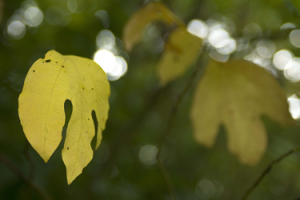Horticultural Highlight: Sassafras
Posted in Gardens and Collections on November 1 2010, by Plant Talk
 |
The Botanical Garden’s living collections is among the greatest in the world and contains more than 1 million plants. Jon Peter, Plant Records Manager, periodically shines the spotlight on a particular species that can be found within our 250 acres. |
 Botanical Name: Sassafras albidum
Botanical Name: Sassafras albidum
Common Name: Sassafras
Family Name: Lauraceae (Laurel family)
Native Range: USA—Maine to Florida, west to Michigan and Texas
Canada—southern Ontario
USDA Hardiness Zones: 5 through 9A
Locations within NYBG: Forest, Everett Children’s Adventure Garden, Native Plant Garden
Site Requirements: Sun to partial shade; well-drained, moist soil
Interesting Note: This species has been used for centuries in a variety of ways. The root bark was used to flavor root beer, the leaves and bark used to make tea, and the oils used in soaps. It was known in folk medicine as a tonic and a purifier of the blood and still has a reputation as a stimulant, and as a treatment for syphilis, rheumatism, and skin disease. Most of these uses ended in the early 1960s when it was found that the active ingredient safrole is carcinogenic.
In the native habitats of North America it has exceptional valuable as a food source for insects, birds, and mammals. The sassafras has many great ornamental qualities as well: from its gorgeous furrowed bark and three forms of leaves to its fragrant twigs and beautiful autumn color. Sassafras is under utilized in the North American landscape.

